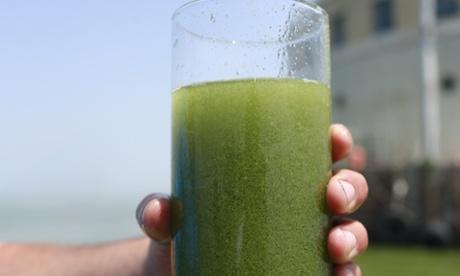by Suzanne Goldenberg / The Guardian

Water problems in the Great Lakes – the world’s largest freshwater system – have spiked in the last three years, largely because of agricultural pollution. Toledo draws its drinking water from Lake Erie.
Residents were warned not to drink the water on Saturday, after inspectors at the city’s water treatment plant detected the toxin known as microcystin. The toxin is produced by microcystis, a harmful blue-green algae; it causes skin rashes and may result in vomiting and liver damage if ingested. It has been known to kill dogs and other animals and boiling the water does not fix the problem; it only concentrates the toxin.
The current bloom of microcystis is concentrated in Maumee Bay in Lake Erie’s western basin, according to the National Oceanic and Atmospheric Administration (NOAA). A second, smaller bloom has appeared in Sandusky Bay.
The main cause for such algal blooms is an overload of phosphorus, which washes into lakes from commercial fertiliser used by farming operations as well as urban water-treatment centres. Hotter and longer summers also promote the spread of the blue-green scum.
The US government banned phosphorus in laundry detergents in 1988. That stopped the algal blooms for some time. But they came back to the Great Lakes in force in 2011 – forming a green scum that covered 5,000 square kilometres (1,900 sq miles) of water at its biggest extent – in the worst algal bloom in recorded history.
Scientists attribute the comeback in large part to changes in farming practices, including larger farms and different fertiliser practices, which send heavier loads of phosphorus into the lakes.
In the 1960s and 1970s, before the ban on phosphorus in laundry detergents, the main sources of phosphorus in Lake Erie were urban and industrial waste. Now it’s farming, which accounts for the vast majority of the phosphorus entering the lake through the Maumee River
An Ohio state government task force found that Lake Erie received the most phosphorus of any of the Great Lakes – 44% of the total for all of the lakes. Two-thirds of that phosphorus came from crop land, with an average load of 1.43lbs per acre, the report found.
There is evidence also that a particular kind of fertiliser could be the main driver of the toxic algal blooms. Researchers from Heidelberg University say there has been a rise in dissolved reactive phosphorus, which is soluble in water and is more available to promote algal growth. The researchers found a decline in the other form of the nutrient, particulate phosphorus, over the same time period.
Circle of Blue, in a major research project on Lake Erie algal blooms, also found a potential link to a switch to no-till farming in nearby farms.
Lake Erie has also grown more susceptible to the algal blooms because of invasive species and climate change. Heavy rains in spring and early summer – a critical time for algal bloom formation – cause more phosphorus to enter the lake through agricultural runoff. Hotter temperatures then cause the blooms to spread.
The NOAA, which has been tracking harmful blooms, forecast a larger than average outbreak of toxic algae this year – although it was expected to fall short of the 2011 record.

